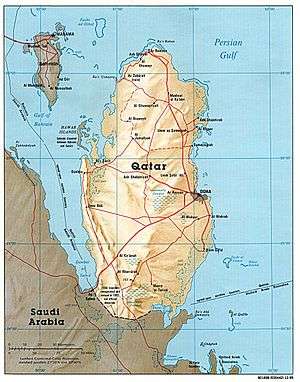Qatar Bahrain Causeway
| Qatar Bahrain Bridge | |
|---|---|
| Coordinates | 26°1′22″N 50°48′8″E / 26.02278°N 50.80222°E |
| Carries | Motor vehicle and Rail |
| Crosses | Gulf of Bahrain |
| Locale | Bahrain and Qatar |
| Other name(s) | Qatar Bahrain Friendship Bridge |
| Maintained by | Qatar and Bahrain Causeway Foundation |
| Characteristics | |
| Total length | 40 km (25 mi) |
| History | |
| Opened | 2022 (planned) |
The Qatar Bahrain Causeway (also referred to as the Qatar Bahrain Friendship Bridge) is a planned causeway between the two Arab states of Qatar and Bahrain. It was announced on 13 December 2008 that construction would start in early 2009,[1] and would cost approximately US$2.3 billion to complete. As of June 2015, construction had not started, and the Qatar-Bahrain Causeway project was on hold, while the contracting consortium involved with the project was said to be demobilising, according to a source at the Qatar Bahrain Causeway Foundation (QBCF).[2] On 14 January 2011, Bahrain's Foreign Minister stated that the project should nevertheless be considered as a must for both countries: "This is one economic market, one economic zone that should be well-connected, and the bridge is an integral part of that".[3][4] On 27 April 2011, an announcement was made, quoting an anonymous source of Bahrain's Al Wasat newspaper, that construction of the causeway would start in 2011 for completion in 2015, at the cost of approximately $5 billion.[5] By December 2012, Bahrain's Foreign Minister was invoking financial turbulence to say that the bridge construction would only be completed by "a little before the 2022 FIFA World Cup." [6]
Overview
The link between the two countries would be approximately 40 km (25 mi) in length, and support both a road and a railway.[7] The link was expected to consist of a number of bridges and be a natural extension of the King Fahd Causeway that connects Bahrain and Saudi Arabia, thus linking the entire region. These links include 18 km (11 mi) of artificial dikes and 22 km (14 mi) of viaducts and bridges. These bridges would be 40 m (131 ft) in height at places to allow maritime navigation. The eastern-end of the causeway in Qatar would be located at Ras Ashairij, 5 km (3 mi) South of the city of Zubarah. The opposite end of the causeway would link North of Askar in the Kingdom of Bahrain.
Plans for its construction were first made in September 2001, when the Danish consultancy COWI signed a DKK 60 million contract for the first phase of the project with the Ministry of Municipal Affairs and Agriculture in Qatar.[8] Together with Sund & Bælt Partner Ltd.,[9] DHI Water & Environment and the architects of Dissing Weitling and COWI conducted pre-studies of the link.[10][11][12]
Milestones
The project was reportedly approved for construction on 28 February 2005, to link Bahrain near Manama to northwest Qatar near Zubarah as the longest fixed link in the world.[13] A formal agreement between the two countries was signed on 11 June 2006 to form a company that would raise the necessary capital and initiate construction.[14]
It was announced on 30 September 2007 that construction should start within seven months and last 48 months.[15] A memorandum of understanding to that effect was then signed between the Qatar and Bahrain Causeway Foundation and a consortium of companies led by French construction major Vinci Construction and the German Company Hochtief Construction AG, CCC and Qatari Diar Real Estate Investment Company.
On 15 November 2008, the Qatar-Bahrain Causeway Foundation awarded a contract to KBR, an engineering company headquartered in Houston, "to provide design, project and construction management services for the Qatar-Bahrain road and rail marine crossing".[16]
In 2009, discussions were entered into to soften the gradient of the bridge to make it more suitable for rail traffic.[17] French architects Thomas Lavigne and Christophe Cheron joined the consortium led by Vinci to design, in collaboration with the engineers, the Causeway and the two main bridges.
In May 2010, Qatari coastguards injured a Bahraini fisherman reigniting a dispute over the Hawar Islands. Escalating costs and the subsequent diplomatic row helped place the project on the back burner.[18]
See also
- King Fahd Causeway
- List of longest bridges in the world
- Transport in Bahrain
- Transport in Qatar
- Bahrain light rail network
References
- ↑ "Work on Qatar-Bahrain causeway to start next month"
- ↑ "Qatar-Bahrain Causeway USD4 bln project on hold - says Qatar Bahrain Causeway Foundation"
- ↑ "Qatar-Bahrain Causeway still planned - MEED.com - 24 May 2011"
- ↑ "GREEN LIGHT"
- ↑ "Qatar-Bahrain causeway to be ready by 2015"
- ↑ "Qatar-Bahrain causeway faces delay, says minister"
- ↑ "Setting standards for the GCC rail network". MEED. Retrieved 2010-11-05.
- ↑ "The Qatar Bahrain causeway, Qatar Bahrain"
- ↑ Sund & Bælt Partner Ltd
- ↑ "Qatar - Bahrain Causeway"
- ↑ "Modelling Studies for the Qatar/Bahrain Causeway Project"
- ↑ "Environmental Impact Assessment Qatar – Bahrain Causeway"
- ↑ "USD4.8bn Qatar, Bahrain causeway" (article dated Feb. 28, 2005, consulted Oct. 7, 2007)
- ↑ "Bahrain-Qatar Causeway Construction to Begin" (article dated June 12, 2006, consulted Oct. 7, 2007)
- ↑ "Construction of Bahrain-Qatar causeway to start next year" (article dated Sept. 30, 2007, consulted Oct. 7, 2007
- ↑ "KBR Awarded Contract by Qatar-Bahrain Causeway Foundation for Project Management of World's Longest Marine Causeway"
- ↑ "Rail link forces redesign of bridge between Qatar and Bahrain"
- ↑ "Qatar Bahrain Causeway in doubt" (article dated June 16, 2010, consulted Oct. 3, 2010)
External links
- Video simulation of the Bridge at Vinci Construction
- Bridge Engineering Study
- Qatari Diar Real Estate Investment Company
- Qatar Bahrain Causeway at Qatarvisitor.com
